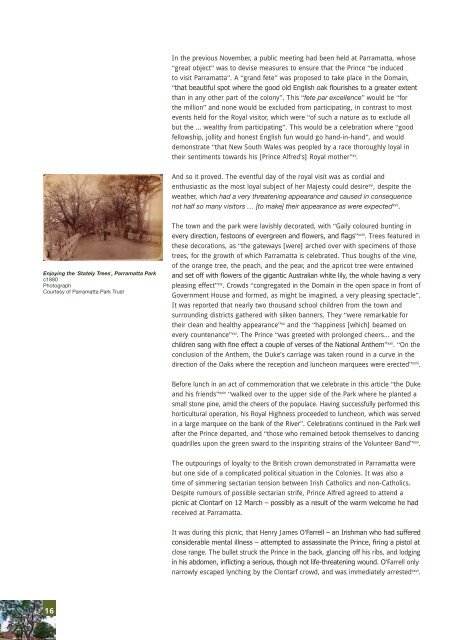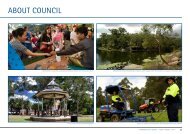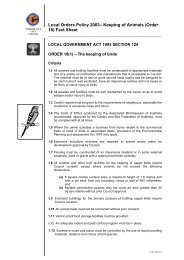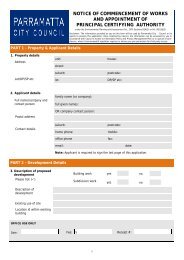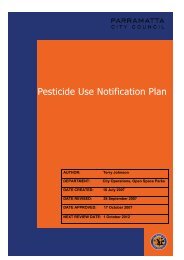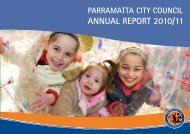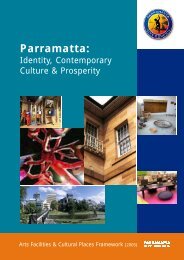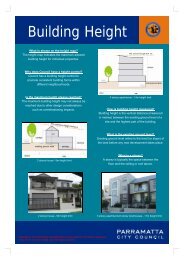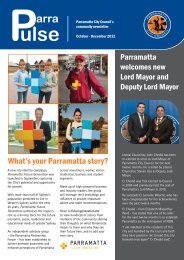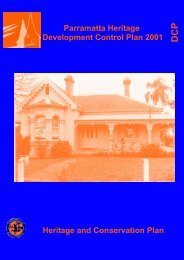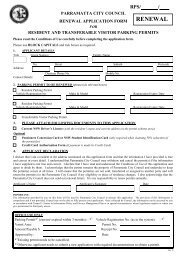Memory of Trees Exhibtion Publication - 2.7 MB - Parramatta City ...
Memory of Trees Exhibtion Publication - 2.7 MB - Parramatta City ...
Memory of Trees Exhibtion Publication - 2.7 MB - Parramatta City ...
You also want an ePaper? Increase the reach of your titles
YUMPU automatically turns print PDFs into web optimized ePapers that Google loves.
Enjoying the ‘Stately <strong>Trees</strong>’, <strong>Parramatta</strong> Park<br />
c1880<br />
Photograph<br />
Courtesy <strong>of</strong> <strong>Parramatta</strong> Park Trust<br />
16<br />
In the previous November, a public meeting had been held at <strong>Parramatta</strong>, whose<br />
“great object” was to devise measures to ensure that the Prince “be induced<br />
to visit <strong>Parramatta</strong>”. A “grand fete” was proposed to take place in the Domain,<br />
“that beautiful spot where the good old English oak flourishes to a greater extent<br />
than in any other part <strong>of</strong> the colony”. This “fete par excellence” would be “for<br />
the million” and none would be excluded from participating, in contrast to most<br />
events held for the Royal visitor, which were “<strong>of</strong> such a nature as to exclude all<br />
but the … wealthy from participating”. This would be a celebration where “good<br />
fellowship, jollity and honest English fun would go hand-in-hand”, and would<br />
demonstrate “that New South Wales was peopled by a race thoroughly loyal in<br />
their sentiments towards his [Prince Alfred’s] Royal mother” xv .<br />
And so it proved. The eventful day <strong>of</strong> the royal visit was as cordial and<br />
enthusiastic as the most loyal subject <strong>of</strong> her Majesty could desire xvi , despite the<br />
weather, which had a very threatening appearance and caused in consequence<br />
not half so many visitors … [to make] their appearance as were expected xvii .<br />
The town and the park were lavishly decorated, with “Gaily coloured bunting in<br />
every direction, festoons <strong>of</strong> evergreen and flowers, and flags” xviii . <strong>Trees</strong> featured in<br />
these decorations, as “the gateways [were] arched over with specimens <strong>of</strong> those<br />
trees, for the growth <strong>of</strong> which <strong>Parramatta</strong> is celebrated. Thus boughs <strong>of</strong> the vine,<br />
<strong>of</strong> the orange tree, the peach, and the pear, and the apricot tree were entwined<br />
and set <strong>of</strong>f with flowers <strong>of</strong> the gigantic Australian white lily, the whole having a very<br />
pleasing effect” xix . Crowds “congregated in the Domain in the open space in front <strong>of</strong><br />
Government House and formed, as might be imagined, a very pleasing spectacle”.<br />
It was reported that nearly two thousand school children from the town and<br />
surrounding districts gathered with silken banners. They “were remarkable for<br />
their clean and healthy appearance” xx and the “happiness [which] beamed on<br />
every countenance” xxi . The Prince “was greeted with prolonged cheers… and the<br />
children sang with fine effect a couple <strong>of</strong> verses <strong>of</strong> the National Anthem” xxii . “On the<br />
conclusion <strong>of</strong> the Anthem, the Duke’s carriage was taken round in a curve in the<br />
direction <strong>of</strong> the Oaks where the reception and luncheon marquees were erected” xxiii .<br />
Before lunch in an act <strong>of</strong> commemoration that we celebrate in this article “the Duke<br />
and his friends” xxiv “walked over to the upper side <strong>of</strong> the Park where he planted a<br />
small stone pine, amid the cheers <strong>of</strong> the populace. Having successfully performed this<br />
horticultural operation, his Royal Highness proceeded to luncheon, which was served<br />
in a large marquee on the bank <strong>of</strong> the River”. Celebrations continued in the Park well<br />
after the Prince departed, and “those who remained betook themselves to dancing<br />
quadrilles upon the green sward to the inspiriting strains <strong>of</strong> the Volunteer Band” xxv .<br />
The outpourings <strong>of</strong> loyalty to the British crown demonstrated in <strong>Parramatta</strong> were<br />
but one side <strong>of</strong> a complicated political situation in the Colonies. It was also a<br />
time <strong>of</strong> simmering sectarian tension between Irish Catholics and non-Catholics.<br />
Despite rumours <strong>of</strong> possible sectarian strife, Prince Alfred agreed to attend a<br />
picnic at Clontarf on 12 March – possibly as a result <strong>of</strong> the warm welcome he had<br />
received at <strong>Parramatta</strong>.<br />
It was during this picnic, that Henry James O’Farrell – an Irishman who had suffered<br />
considerable mental illness – attempted to assassinate the Prince, firing a pistol at<br />
close range. The bullet struck the Prince in the back, glancing <strong>of</strong>f his ribs, and lodging<br />
in his abdomen, inflicting a serious, though not life-threatening wound. O’Farrell only<br />
narrowly escaped lynching by the Clontarf crowd, and was immediately arrested xxvi .


